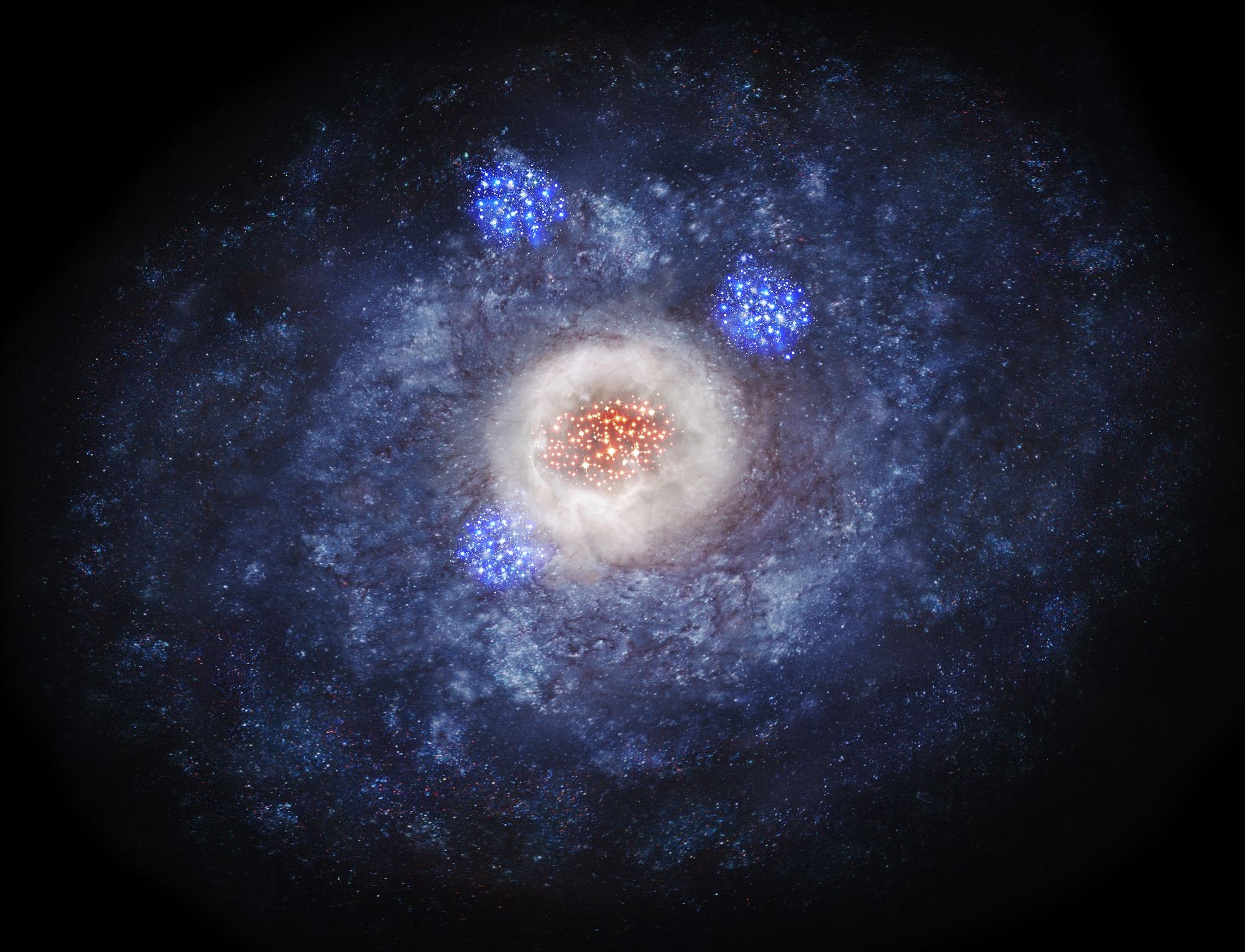

Artist’s impression of a disk galaxy transforming in to an elliptical galaxy. Stars are actively formed in the massive reservoir of dust and gas at the center of the galaxy. Credit: NAOJ
In 1926, famed astronomer Edwin Hubble developed his morphological classification scheme for galaxies. This method divided galaxies into three basic groups – Elliptical, Spiral and Lenticular – based on their shapes. Since then, astronomers have devoted considerable time and effort in an attempt to determine how galaxies have evolved over the course of billions of years to become these shapes.
One of th most widely-accepted theories is that galaxies changed by merging, where smaller clouds of stars – bound by mutual gravity – came together, altering the size and shape of a galaxy over time. However, a new study by an international team of researchers has revealed that galaxies could actually assumed their modern shapes through the formation of new stars within their centers.
The study, titled “Rotating Starburst Cores in Massive Galaxies at z = 2.5“, was recently published in the Astrophysical Journal Letters. Led by Ken-ichi Tadaki – a postdoctoral researcher with the Max Planck Institute for Extraterrestrial Physics and the National Astronomical Observatory of Japan (NAOJ) – the team conducted observations of distant galaxies in order to get a better understanding of galactic metamorphosis.
This involved using ground-based telescopes to study 25 galaxies that were at a distance of about 11 billion light-years from Earth. At this distance, the team was seeing what these galaxies looked like 11 billion years ago, or roughly 3 billion years after the Big Bang. This early epoch coincides with a period of peak galaxy formation in the Universe, when the foundations of most galaxies were being formed. As Dr. Tadaki indicated in a NAOJ press release:
“Massive elliptical galaxies are believed to be formed from collisions of disk galaxies. But, it is uncertain whether all the elliptical galaxies have experienced galaxy collision. There may be an alternative path.”
Capturing the faint light of these distant galaxies was no easy task and the team needed three ground-based telescopes to resolve them properly. They began by using the NAOJ’s 8.2-m Subaru Telescope in Hawaii to pick out the 25 galaxies in this epoch. Then they targeted them for observations with the NASA/ESA Hubble Space Telescope (HST) and the Atacama Large Millimeter/submillimeter Array (ALMA) in Chile.
Whereas the HST captured light from stars to discern the shape of the galaxies (as they existed 11 billion years ago), the ALMA array observed submillimeter waves emitted by the cold clouds of dust and gas – where new stars are being formed. By combining the two, they were able to complete a detailed picture of how these galaxies looked 11 billion years ago when their shapes were still evolving.
What they found was rather telling. The HST images indicated that early galaxies were dominated by a disk component, as opposed to the central bulge feature we’ve come to associate with spiral and lenticular galaxies. Meanwhile, the ALMA images showed that there were massive reservoirs of gas and dust near the centers of these galaxies, which coincided with a very high rate of star formation.
To rule out alternate possibility that this intense star formation was being caused by mergers, the team also used data from the European Southern Observatory’s Very Large Telescope (VLT) – located at the Paranal Observatory in Chile – to confirm that there were no indications of massive galaxy collisions taking place at the time. As Dr. Tadaki explained:
“Here, we obtained firm evidence that dense galactic cores can be formed without galaxy collisions. They can also be formed by intense star formation in the heart of the galaxy.”
These findings could lead astronomers to rethink their current theories about galactic evolution and howthey came to adopt features like a central bulge and spiral arms. It could also lead to a rethink of our models regarding cosmic evolution, not to mention the history of own galaxy. Who knows? It might even cause astronomers to rethink what might happen in a few billion years, when the Milky Way is set to collide with the Andromeda Galaxy.
As always, the further we probe into the Universe, the more it reveals. With every revelation that does not fit our expectations, our hypotheses are forced to undergo revision.
Further Reading: ALMA, Astrophysical Journal Letters
How can we explore Saturn’s moon, Enceladus, to include its surface and subsurface ocean, with…
Have you ever wondered how astronomers manage to map out the Milky Way when it's…
NASA astronomers have been continuing to monitor the trajectory of asteroid 2024 YR4. The initial…
Some exoplanets have characteristics totally alien to our Solar System. Hot Jupiters are one such…
Stars form in Giant Molecular Clouds (GMCs), vast clouds of mostly hydrogen that can span…
Let’s dive into one of those cosmic curiosities that's bound to blow your mind: how…